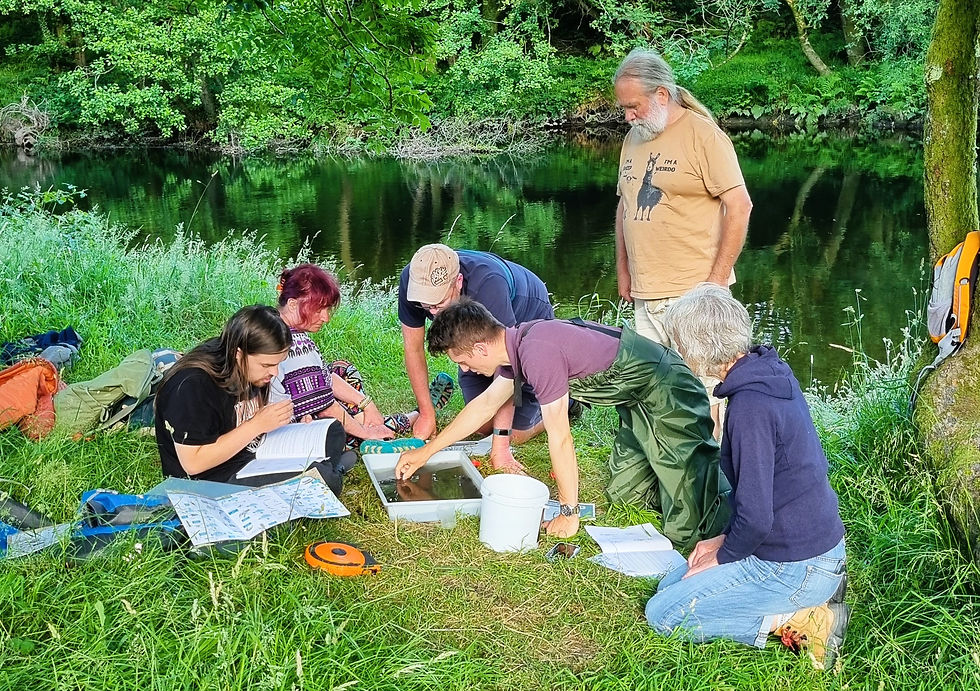Designing a regenerative future for the Biosphere
- dyfibiosphere
- Jul 29
- 4 min read
Carl Meddings of the Centre for Alternative Technology describes how students at their summer school visioned a regenerative future for the area. Darllen yn Gymraeg

In July, the Centre for Alternative Technology (CAT) held its first Architecture Summer School focussed on the theme of regenerative futures, and chose as its focus the Dyfi Biosphere.
The Centre for Alternative Technology is an environmental education centre dedicated to researching and communicating positive solutions for environmental change, based in the regenerated Llwyngwern Quarry, north of Machynlleth. As part of this, CAT provides Masters-level education in a wide range of topics related to sustainability, including a Masters in Sustainable Architecture (M.Arch) for students training to be architects.
Building on the success of that course, the Summer School was aimed at undergraduate architecture students who wanted to broaden their understanding of regenerative practices, localism, heritage significance, community resilience, biodiversity and habitat diversity, and the fundamental interconnectedness of human and more-than-human systems. What better place to explore these ideas than the Dyfi Biosphere?
In the event we had more than architecture students in attendance. Of the fourteen people who joined the course, two were just doing their A levels and another two had travelled from Donegal in the Republic of Ireland, where they are currently nurturing their own regenerative farm.

Being there
The group travelled around the Biosphere, starting at CAT in the (very rainy) Celtic Rainforest and ending at (a very windy) Borth. Together we visited the Taj Mahal Community Hub in Machynlleth where we met Sandra Bendelow and heard all about the wide range of community activities and opportunities that they support.
We travelled, via The Dyfi Wildlife project (to see the Ospreys and their fledglings) to Coetir Anian where we met Cian Llywelyn who was able to tell us about the gentle, careful work that they are doing and show us the buildings at Bwlch Corog, which are themselves a really lovely and interesting study in sustainability, given that they’re largely built from materials sourced within the site itself. Our final destination was Borth and Ynyslas, where the summer school attendees explored the town and its precarious connection to both the sea and the land.
Being gentle
On return to CAT, we discussed ideas for the future of the Dyfi Biosphere through a Three Horizons workshop developed by CAT’s own Innovation Lab and Zero Carbon Hub. This is designed to enhance and provoke positive, critical futures thinking, and students were invited to contemplate a future where ‘By 2050 the Dyfi biosphere is a place where gentle interventions have guided a thriving local community and a healthy ecosystem’.
This was followed by a Deep Mapping exercise run by tutors on the M.Arch Sustainable Architecture course, exploring creative expressions of the future by asking participants to develop ‘gentle catalysts for resilience’ for human and more-than-human occupants of the area.
Final outputs from participants included proposals for:
Recipes for local food, sourced, cooked and beautifully served for all to share,
A mobile community centre in a converted bus, scheduled to travel from place to place as community needs dictate
An event taking place in 2050 - being the imagined 25th anniversary of a festival called Cymorth Borth, that celebrates the communal resilience and mutual support for the inhabitants of Borth and Beyond in the face of the impacts of climate change,
A prototype for a community shelter and living room (based on an extended telephone booth) designed to provide positive mental health support and guidance
A food library to promote community gathering, food production, education, sharing and nourishment
A methodology for community engagement drawing on stories and shared experiences, histories and narratives - that are always richer than any map can contain.
“Everyone was welcoming and kind, and it was amazing to have such interesting conversations and do such interesting work as a result of that. The celebratory nature of the product at the end, which I guess, since the 'catalyst' was rooted in care, was also really refreshing.” Ashleigh Rizza – participant
CAT offers the only rural-based and sustainability-focused architecture course in the UK. We define sustainable architecture through fully acknowledging the impact of humanity on our planet and the need to act now. We provide the tools for our students to create architecture and healthy places that are appropriate for a world where eco-centric values are held as equal to anthropocentric ones.
Thanks must go to the many people that helped make the week so special, including
Jane Powell, Cydlynydd Biosffer Dyfi, Sandra Bendelow, Coordinator Taj Mahal Community Hub, Cian Llywelyn, Coetir Anian, Rachel Tuckett, Ruth Stevenson and Paul Allen from CAT’s Innovation Lab and Zero Carbon Hub, Owen Griffiths, artist, curator workshop leader and facilitator, Alice Briggs, project manager Tir Canol, Becca Thomas of New Practice, part of Civic, based in Glasgow and Zoe Quick, architect and visiting lecturer at CAT.
This is the first Architecture Summer School a CAT. We hope it is the first of many more to come.
Dr Carl Meddings is the Programme Leader for CAT's MArch: Sustainable Architecture course. He is an architect and educator with a passion for educating architects in a rapidly changing cultural and professional environment. His design ethos is rooted in critical regionalism; the exploration of appropriate architecture that is culturally, socially and environmentally responsive. He has taught at all levels from first-year undergraduate to final year masters level and beyond.
Images: Myfi Fenwick, Ashleigh Rizza.






Many thanks for bringing the group to Bwlch Corog, Carl. It was really special to host such an engaged group, who asked lots of inciteful questions about the wider context of what Coetir Anian does. It was really pleasing that they clearly wanted to understand how what they were studying fits into the area around CAT, and its distinct natural, cultural and linguistic heritage. We'd be delighted to welcome you back in future years.